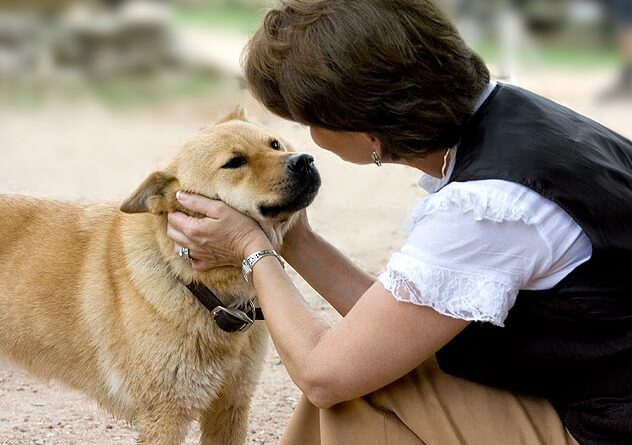Dog – Human Communication: Intentional vs Unintentional Cues
In a study done about intentional vs unintentional signaling to dogs, it was found that dogs clearly differentiate between the pointing and gazing cues by responding to intentional signals. Dogs differentiated acts in which a human communicated a location to them, from situations in which the human produced similar but non-communicative movements in the same direction, meaning that dogs do not follow just any directional behavior of a human. The main cue that indicated their human’s intent of communication was eye contact the main cue indicating the human’s intentional communicative act was eye contact, which goes to prove that eye contact is very important in dog–human interactions. However another experiment showed that eye contact was not very important as the dog was still able to recognize that a cue was meant for them when their owner had their back to the item being signaled.
This study did show that the dog did not respond to their name, but to the infant-directed speech like that humans have when addressing their pet. The dogs were able to ignore the cue when it was directed to another human rather than to them. Although the previous study said that eye contact was not important the third study showed that dogs used communicative gestures much more when there was eye contact, and whether their name was called did not affect their performance. The same findings have been found in puppies who have had very limited human interaction. (Kaminski, 2012) Human gaze is not only important to animals when trying to do what their owner says, but dogs also look at their human in situations of conflict and uncertainty. Research shows that gaze is a learned behavior as humans positively reinforce the dog by comforting it when they seek their owner’s comfort. (Barrera, 2011).
Human body language is also important in communicating with dogs. Research shows that dogs can interpret human gestures as imperative commands for them to do something or as informative, as their human tells them the information that the dog seeks. This type of communication is also more effective when telling the dog where certain things can be found such as food or toys, but it is not very effective when telling the dog what they should or shouldn’t do. (Petterson, 2011) Research has also showed that dogs are able to tell human’s aggressive behavior by the body movement and vocal cues they exhibit, making the dog be friendlier towards the nicer person. (Merola, 2012) The cues they need to determine who the nicer person is is picked up through social eavesdropping between humans interacting with one another. (Marshall-Pescini, 2011)
In the study done by Kundey we learned that dogs are able to predict human behavior just by watching humans interact, which is the same thing that Marshall-Pescini found in his study. Although dogs have been found to respond to human cues very well, they seem to communicate with humans to request information they need (food, water, toys) rather than to give their owner the information they need (shoe/leash location). However, when the dog does communicate with the human, it is to tell a location rather than a thing, but it is usually because the location has something the dog wants, such as their toys. (Kaminski, 2011) Research shows that domesticated dogs have evolved to be cooperative and trusting of humans, and that they require physical contact, such as petting, from their owners to maintain social affection (Kuhne, 2012) making them almost like human children unlike any other mammal including primates (Pettersson, 2011)
References
Barrera, G., Mustaca, A., & Bentosela, M. (2011). Communication between domestic dogs and humans: Effects of shelter housing upon the gaze to the human. Animal Cognition, 14(5), 727-734. doi:10.1007/s10071-011-0407-4
Kaminski, J., Neumann, M., Bräuer, J., Call, J., & Tomasello, M. (2011). Dogs, Canis familiaris, communicate with humans to request but not to inform. Animal Behaviour, 82(4), 651-658. doi:10.1016/j.anbehav.2011.06.015
Kaminski, J., Schulz, L., & Tomasello, M. (2012). How dogs know when communication is intended for them.Developmental Science, 15(2), 222-232. doi:10.1111/j.1467-7687.2011.01120.x
Kuhne, F., Hößler, J. C., & Struwe, R. (2012). Effects of human–dog familiarity on dogs’ behavioural responses to petting. Applied Animal Behaviour Science, 142(3-4), 176-181. doi:10.1016/j.applanim.2012.10.003
Kundey, S. A., De Los Reyes, A., Royer, E., Molina, S., Monnier, B., German, R., & Coshun, A. (2011). Reputation-like inference in domestic dogs (Canis familiaris). Animal Cognition, 14(2), 291-302. doi:10.1007/s10071-010-0362-5
Marshall-Pescini, S. S., Passalacqua, C. C., Ferrario, A. A., Valsecchi, P. P., & Prato-Previde, E. E. (2011). Social eavesdropping in the domestic dog. Animal Behaviour, 81(6), 1177-1183. doi:10.1016/j.anbehav.2011.02.029
Merola, I. I., Prato-Previde, E. E., & Marshall-Pescini, S. S. (2012). Social referencing in dog-owner dyads?. Animal Cognition, 15(2), 175-185. doi:10.1007/s10071-011-0443-0
Pettersson, H., Kaminski, J., Herrmann, E., & Tomasello, M. (2011). Understanding of human communicative motives in domestic dogs. Applied Animal Behaviour Science, 133(3-4), 235-245. doi:10.1016/j.applanim.2011.05.008




